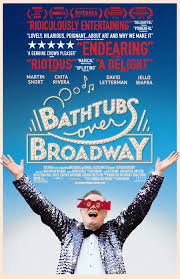Bathtubs Over Broadway
Posted on December 16, 2018 at 11:08 am
B +| Lowest Recommended Age: | Middle School |
| MPAA Rating: | Rated PG-13 for brief language |
| Profanity: | Brief strong language |
| Alcohol/ Drugs: | None |
| Violence/ Scariness: | Sad death |
| Diversity Issues: | None |
| Date Released to Theaters: | December 14, 2018 |

There are really three stories in this adorably engaging documentary about “industrial musicals,” the wildly elaborate in-house productions big corporations used to motivate their employees in the 1950’s-70’s. The first is the story of our guide to this world, Steve Young, a writer for David Letterman’s Late Show who describes himself as comedically “damaged” after years of evaluating everything in the world as comedy material. There was almost nothing that made him laugh anymore. The best he could muster was an analytic, “that’s funny.” “We’ve become hard laughs,” he tells us. Over the course of the film, he will lose the job he has had for two decades when Letterman decides to retire. The second, as in many documentaries, is the story of a tiny sub-culture of people who are deeply passionate about something the rest of the world considers odd or quirky or has never heard of. This one lives “at the far horizon where the adjectives of ‘good’ and ‘bad’ don’t apply anymore.” Young may have found them as something to laugh at but he soon develops affection and then passion for them, and by the end of the movie, we can understand why and feel some of it ourselves.
“How can there be something so large and so crazy in the world that we had no idea of?” Young asks. But the answer we get is to a different question: How can an “eccentric adventure” soothe and enlarge a “comedy-damaged” soul? By the end of the film, Young tells us that delving into this odd world has “opened up my ability to be receptive to people.” Anyone he meets can have this kind of history.
And the third is the story of the musicals themselves, often produced, directed, and performed by actual or future Broadway stars, making a very good living doing something they loved and could learn from instead of waiting tables. Just to give you an idea: one of these musicals had a budget of three million dollars. The original production of “My Fair Lady,” which opened the same season on Broadway, had a budget of $466,000. Were they works of art? Well, no, they had singing and dancing spark plugs and ballads about toilets and an opera about spaghetti sauce called “Raguletto.” But they were very professionally done, often quite clever, astonishingly elaborate, and in their own way artifacts of an era of corporate optimism that saw endless possibilities for itself as providers of consumer goods and great jobs. Of course those jobs were for white males, as we see in the glimpses we get of the audience, all wearing near-identical suits and ties.
“I played a trick on history,” Young tells us. These shows were created for the most specific of audiences and were never intended to be seen by outsiders. The biggest surprise is that these most commercial of enterprises are so free from any kind of cynicism. There’s an innocence about them because they come from the post-WWII era, when America seemed unbeatable, and technology seemed thrilling. The “man in a grey flannel suit” corporate employees were “being shown a version of their world where they’re heroes.” If a marvelous new substance called silicone had 180 uses, why not create a song about it? What better way to introduce fabulous new products to the sales team than a catchy musical number? It may have been the “strangest dead end of show business,” with the idea of “What shouldn’t we write a musical about? Let’s write it and make it good and not let anyone see it!” But companies with lavish budgets created souvenir records for their employees to take home and that is how Young began to discover this world of unseen, un heard entertainment. Over the course of the film he tracks down some of the creators and performers, including Susan Stroman (“The Producers”), who explains that she learned a lot from choreographing industrial shows, Martin Short and Florence Henderson, who talk about the pleasures of performing for wildly enthusiastic audiences (Henderson compares it to a revival meeting), and composer Sid Siegel, who specialized in industrial musicals — and who kept a treasure trove of an archive. They were “selling Tupperware but also selling America,” and their unabashed boosterism makes it impossible to be snarky or condescending, leaving us entertained, and perhaps a little wistful.
Parents should know that this film includes brief strong language and a sad death.
Family discussion: If you were going to create a musical about your job or school, what would you sing about? Which production was your favorite?
If you like this, try: the shows by Sheldon Harnick, Chita Rivera, and Martin Short, and the book by Steve Young. Some of the songs are available, too.
